
- Ethnic African American
- Artist
- Albert Fennell (4)
- Annette (4)
- Annie Lee (5)
- Byron Lars (21)
- Charles Bibbs (13)
- Dr. Lisa (5)
- Earl Jackson (3)
- Johnnie (6)
- Karen Germany (10)
- Kate Wiggs (3)
- Kelly Rogers (8)
- Martha Holcombe (7)
- Mary Blair (7)
- Mattel (6)
- Maynard Arnett (5)
- Patricia Rose (4)
- Paul Goodnight (3)
- Shady Ladies Dolls (12)
- Thomas Blackshear (4)
- Unknown (15)
- Other (1032)
- Signed
- Signed By
- Size
- Title
- Unit Of Sale
RARE Vintage BLACK PANTHER African American FREE HUEY Poster, MOSLEY 1969
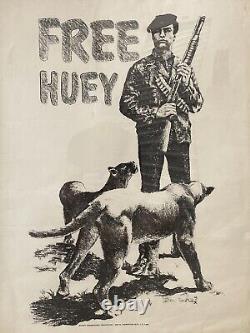
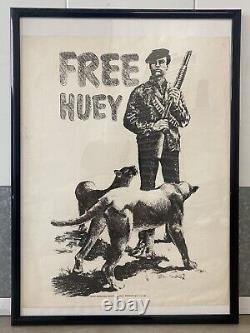

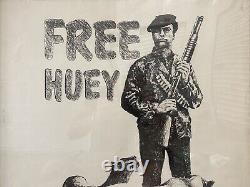
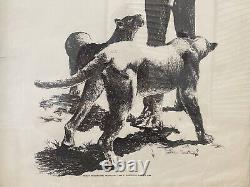

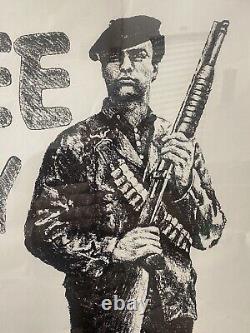
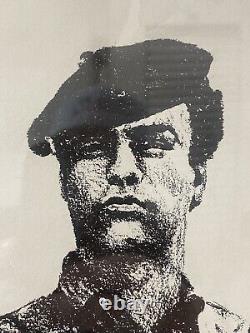
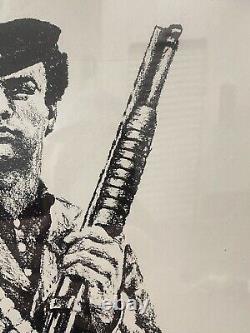
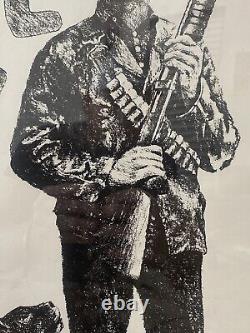

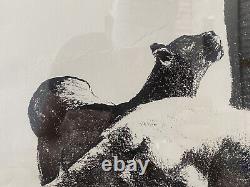
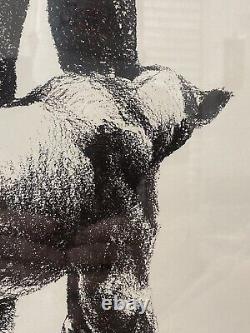

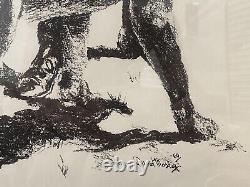
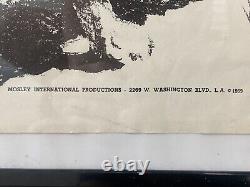


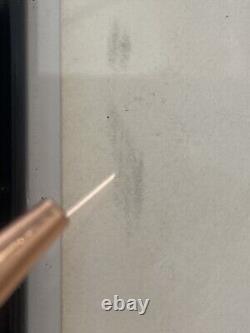



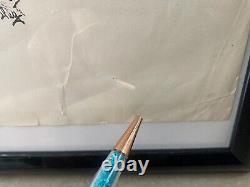
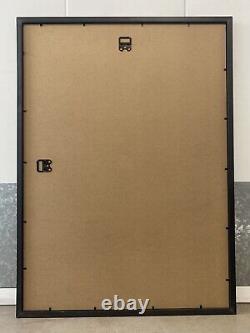


This is a historic and Very RARE Vintage BLACK PANTHER PARTY African American FREE HUEY Poster, designed by artist David Mosley b. 1941, and produced in 1969, to advocate for the release of Black Panther Party founder, Huey P. Newton (1942 - 1989) from his prison confinement for the alleged 1967 murder of Oakland, California police officer, John Frey. This poster depicts Huey Newton standing proudly in a black leather jacket, wearing a black beret and holding a shotgun.
At his legs are two large black panthers, a melanistic color variant of the leopard and jaguar families. This artwork reads: "FREE HUEY" in bold letters at the top of the poster. In small font, at the center lower edge, it reads: Mosley International Productions - 2269 W.
" It is also signed and dated in plate by the artist, at the lower right edge: "David Mosley'69. This poster and the original artwork were created by David Mosley, a Louisiana poster artist who is known for his charcoal drawings of several figures involved with the Black Panthers, Civil Rights, and Black Power movements.
These subjects include Kathleen Cleaver, Angela Davis, and Malcolm X, among others. Which is the SECOND Edition. That version reads at the center lower edge: Frank Kay Distributors, Inc.
You cannot and will not find another first edition Free Huey poster, it is exceedingly scarce. Approximately 21 1/4 x 29 1/8 inches including frame. Actual poster is approximately 19 x 24 7/8 inches. Good overall condition for age, and the ephemeral nature of this particular type of political poster.
There are several small tears along the edges, light - mild creasing throughout, and faint spots of soiling to the surface please see photos carefully. Additionally, there is a small crack in the plastic "glass" of the frame, visible near the top right edge of the actual poster Photo 21.I found this historic item rolled up in a tube in the bottom of a cardboard box, and quickly placed it in a cheap Michael's frame for immediate protection. I strongly suggest re-framing this important piece in an archival quality frame. Original posters designed by David Mosely are housed in the permanent collections of the Oakland California Museum of Art OCMA.
Acquired from an old collection in Leimert Park, Los Angeles County, California. If you like what you see, I encourage you to make an Offer. Please check out my other listings for more wonderful and unique artworks! David Mosley was born in Shreveport, Louisiana in 1941, moved to Watts, L. As a child, and is best known for his charcoal drawings of figures across the Black Power and Civil Rights movements, including Angela Davis, Malcolm X, and Huey Newton.
He studied at the L. Trade Technical College, the University of Ghana, and the Otis Art Institute in L. He started drawing portraits of inmates' loved ones in San Quentin Prison where he served a three-year sentence and where he was encouraged by George Jackson to put his talents to work for Black communities. David Mosley (born 1941) is probably best known for the millions of poster reprints of his work that have been distributed worldwide since the 1960s. He was born in Shreveport, Louisiana, and moved to Watts at age three.
An early involvement with gangs landed him in San Quentin Prison where he got to know revolutionary George Jackson, who helped him redirect his life in a more community-minded, creative direction. Upon his release he immediately enrolled in school, studying the technical aspects of art. ICONIC: BLACK PANTHER, Gregorio Escalante Gallery. Huey Percy Newton (February 17, 1942 - August 22, 1989) was an African American. Revolutionary and political activist who founded the Black Panther Party.
He ran the party as its first leader and crafted its ten-point manifesto. Under Newton's leadership, the Black Panther Party founded over 60 community support programs. (renamed survival programs in 1971) including food banks. Medical clinics, sickle cell anemia.
Tests, prison busing for families of inmates, legal advice seminars, clothing banks, housing cooperatives, and their own ambulance service. The most famous of these programs was the Free Breakfast for Children.Program which fed thousands of impoverished children daily during the early 1970s. Newton also co-founded the Black Panther newspaper service. Which became one of America's most widely distributed African American newspapers. In 1967, he was involved in a shootout which led to the death of police officer John Frey and injuries to himself and another police officer.
In 1968, he was convicted of voluntary manslaughter. For Frey's death and sentenced to 2 to 15 years in prison. In May 1970, the conviction was reversed and after two subsequent trials ended in hung juries, the charges were dropped.
Later in life, he was also accused of murdering Kathleen Smith and Betty Van Patter. Although he was never convicted for either death. Newton learned to read using Plato's Republic. Which influenced his philosophy of activism.
He went on to earn a PhD. From the University of California at Santa Cruz's History of Consciousness. In 1989, he was murdered in Oakland, California by Tyrone Robinson, a member of the Black Guerrilla Family. Newton was known for being an advocate of the right of self-defense. And used his position as a leader within the Black Panther Party to welcome women as well.
Newton was born in Monroe, Louisiana in 1942 during World War II, the youngest child of Armelia Johnson and Walter Newton, a sharecropper. His parents named him after Huey Long. Monroe is located in Louisiana's Ouachita Parish. Which has had a history of violence against Black people since the Reconstruction era.
According to a 2015 report by the Equal Justice Initiative. From 1877 to 1950, a total of 37 Black people were documented as lynched. Most murders had taken place around the turn of the 20th century. This was the fifth-highest total of lynchings of any county in the Southern United States. As a response to the violence, the Newton family migrated to Oakland, California, participating in the second wave of the Great Migration.Of African Americans out of the South. The Newton family was close-knit but quite poor.
They moved often within the San Francisco Bay Area during Newton's childhood. Despite this, Newton said he never went without food and shelter as a child. As a teenager, he was arrested several times for criminal offenses, including gun possession and vandalism at age 14. Growing up in Oakland, Newton stated that he was "made to feel ashamed of being black". During those long years in Oakland public schools, I did not have one teacher who taught me anything relevant to my own life or experience.
Not one instructor ever awoke in me a desire to learn more or to question or to explore the worlds of literature, science, and history. All they did was try to rob me of the sense of my own uniqueness and worth, and in the process nearly killed my urge to inquire. Newton graduated from Oakland Technical High School.
Where he earned an Associate of Arts degree in 1966. Was an influential work in Newton's early adult life. He told the court during the. Trial for the killing of officer John Frey. That he had learned to read from studying the.
After that, he started "questioning everything". In his autobiography, Revolutionary Suicide. He states: Most of all, I questioned what was happening in my own family and in the community around me. Newton continued his education, studying at San Francisco Law School, and the University of California at Santa Cruz, where he earned a bachelor's degree.
He was a member of Phi Beta Sigma. He later continued his studies, and, in 1980, he completed a PhD. Founding of the Black Panther Party. As a student of the Merritt College in Oakland, Newton became involved in Bay Area politics.
He joined the Afro-American Association. (AAA), became a prominent member of Phi Beta Sigma. Fraternity's Beta Tau chapter, and played a role in getting the first African American history.
Course adopted as part of the college's curriculum. Newton learned about black history from Donald Warden (who later would change his name to Khalid Abdullah Tariq Al-Mansour), the leader of the AAA. Later Newton concluded that Warden offered solutions that didn't work. In his autobiography, Newton says of Warden, The mass media, the oppressors, give him public exposure for only one reason: he will lead the people away from the truth of their situation.
In college, Newton read the works of Karl Marx. During his time at Merritt College, he met Bobby Seale.With whom he co-founded the Black Panther Party for Self Defense. Based on a casual conversation, Seale became chairman, and Newton became minister of defense. The Black Panther Party was an African American left-wing organization advocating for the right of self-defense. For black people in the United States. The Black Panther Party's beliefs were greatly influenced by Malcolm X.
The party achieved national and international renown through their deep involvement in the Black Power. Movement and the politics of the 1960s and 1970s. The party's political goals, including better housing, jobs, and education for African Americans, were documented in their Ten-Point Program. A set of guidelines to the Black Panther Party's ideals and ways of operation. The group believed that violence - or the threat of it - might be needed to bring about social change. They sometimes made news with a show of force, as they did when they entered the California Legislature fully armed in order to protest a gun bill aimed at disarming them. Newton adopted what he termed revolutionary humanism.Although he had previously attended. Mosques, he wrote that I have had enough of religion and could not bring myself to adopt another one. I needed a more concrete understanding of social conditions.
Did not satisfy my stubborn thirst for answers. Newton later decided to join a. After the party disbanded during his marriage to Fredrika. Newton would frequent pool halls, campuses, bars and other locations deep in the black community where people gathered in order to organize and recruit for the Panthers.
While recruiting, Newton sought to educate those around him about the legality of self-defense. One of the reasons, he argued, why Black people continued to be persecuted was their lack of knowledge of the social institutions that could be made to work in their favor. In Newton's autobiography, Revolutionary Suicide, he writes, Before I took Criminal Evidence in school, I had no idea what my rights were. Newton also wrote in his autobiography, I tried to transform many of the so-called criminal activities going on in the street into something political, although this had to be done gradually.
" He attempted to channel these "daily activities for survival into significant community actions. Eventually, the illicit activities of a few members would be superimposed on the social program work performed by the Panthers, and this mischaracterization would lose them some support in black communities and white. Newton and the Panthers started a number of social programs in Oakland, including founding the Oakland Community School, which provided high-level education to 150 children from impoverished urban neighborhoods. Other Panther programs included the Free Breakfast for Children Program. And others that offered dances for teenagers and training in martial arts.According to Oakland County Supervisor John George: Huey could take street-gang types and give them a social consciousness. In the wake of the embezzlement charges, Newton disbanded the Black Panther Party. The embezzlement charges were dropped six years later in March 1989, after Newton pleaded no contest. He was sentenced to six months in jail and 18 months probation. Fatal shooting of John Frey.
Newton had been convicted of assault with a deadly weapon for repeatedly stabbing another man, Odell Lee, with a steak knife in mid-1964. He served six months in prison. By October 27-28, 1967, he was out celebrating the release from his probationary period. Just before dawn on October 28, Newton and a friend were pulled over by Oakland Police Department officer John Frey. Realizing who Newton was, Frey called for backup. After fellow officer Herbert Heanes arrived, shots were fired, and all three were wounded. Heanes testified that the shooting began after Newton was under arrest, and one witness testified that Newton shot Frey with Frey's own gun as they wrestled. No gun on either Frey or Newton was found.Newton stated that Frey shot him first, which made him lose consciousness during the incident. Frey was shot four times and died within the hour, while Heanes was left in serious condition with three bullet wounds.
Took Newton to Oakland's Kaiser Hospital, where he was admitted with a bullet wound to the abdomen. Newton was soon handcuffed to his bed and arrested for Frey's killing. A doctor, Thomas Finch, and nurse, Corrine Leonard, attended to Newton when he arrived at the hospital, and Finch stated that Newton was "agitated" when asking for treatment and that Newton was given a tranquilizer to calm him.
Newton was convicted in September 1968 of voluntary manslaughter. For the killing of Frey and was sentenced to 2 to 15 years in prison. In May 1970, the California Appellate Court reversed the conviction and ordered a new trial.
After two subsequent trials ended in hung juries, the district attorney said he would not pursue a fourth trial, and the Alameda County Superior Court dismissed the charges. In his autobiography, Revolutionary Suicide , Newton wrote that Heanes and Frey were opposite each other and shooting in each other's direction during the shootout. Hugh Pearson, in his book Shadow of the Panther, writes that Newton, while intoxicated, boasted about having willfully killed Frey. Newton was arrested on the day of the shooting on October 28, 1967, and pled not guilty to the murder of officer John Frey. The Black Panther Party immediately went to work organizing a coalition to rally behind Newton and champion his release. In December the Peace and Freedom Party.A majority white anti-war political organization, joined with the Black Panther Party in support of Newton. This alliance served the dual purpose of legitimizing Newton's cause while boosting the credibility of the party within the community of more radical activists. Under the leadership of the Black Panther Party and the Peace and Freedom Party, 5,000 protesters gathered in Oakland on Newton's birthday, February 17, 1968, in support of Newton. They garnered the attention of international news organizations, raising the profile of the party by astounding measures. Was adopted as a rallying cry for the movement, and it was printed on buttons and T-shirts.
Prominent Black Panther Kathleen Cleaver. Claimed the goal of the Free Huey! Campaign was to elevate Newton as a symbol of everything the Black Panther Party stood for, creating something of a living martyr. The trial, which began on July 15, quickly ascended beyond the scope of Newton himself, evolving into a racially-charged political movement.Over the two-year course of Newton's original trial and two appeals, the coalition continued to offer its support until the charges were overturned and Newton was released on August 5, 1970. N 1970, after his release from prison, Newton received an invitation to visit the People's Republic of China. On learning of Nixon's plan to visit China in 1972, Newton decided to visit before him.
Newton made the trip in late September 1971 with fellow Panthers, Elaine Brown. And stayed for 10 days. At every Chinese airport he landed in, Newton was greeted by thousands of people waving copies of the "Little Red Book" officially titled.
Quotations from Chairman Mao Tse-Tung. And displaying signs that said, We support the Black Panther Party, down with U. Imperialism, " or "We support the American people, but the Nixon imperialist regime must be overthrown. During the trip, the Chinese arranged for him to meet and have dinner with an ambassador from North Korea, an ambassador from Tanzania, and delegations from both North Vietnam and the Provisional Revolutionary Government of South Vietnam. Newton was under the impression he was going to meet.Chairman of the Chinese Communist Party. But instead had two meetings with.
One of these meetings also included Mao's wife. Newton described China as "a free and liberated territory with a socialist government". Following Newton's Asian trip, the Black Panther Party began incorporating North Korea's.Ideals into the party's ideology. Peoples Temple of the Disciples of Christ. In January 1977, Jim Jones. Leader of the Peoples Temple of the Disciples of Christ commonly shortened to the Peoples Temple.
, visited Newton in Havana, Cuba. That same year after Jones fled to Jonestown. He established in Guyana for his followers, Newton spoke to Temple members in Jonestown via telephone expressing support for Jones during one of the Temple's earliest White Nights. Newton's cousin, Stanley Clayton, was one of the few residents of Jonestown to escape the area before the 1978 mass murder of over 900 Temple members by Jones and his enforcers through forced suicide. By the 1970s, Newton had allegedly become increasingly paranoid, addicted to crack cocaine.
And prone to violent behavior. On August 6, 1974, Kathleen Smith, a 17-year-old Oakland native and child prostitute was shot. She died three months later. A childhood nickname he hated.
The main witness of this case refused to testify due to an assassination attempt against her and, after two. Trials, Newton was not convicted. Newton is also alleged to have assaulted his tailor over the price of a suit. After being arrested for pistol-whipping.
Newton and his girlfriend (later his wife) Gwen Fontaine then fled to Havana, Cuba, where they lived until 1977. Which prevented further prosecution on the two charges. Took over as chairperson of the Black Panther Party in his absence.
In October 1977, three Black Panthers attempted to assassinate Crystal Gray, a key prosecution witness in Newton's upcoming trial who had been present the day of Kathleen Smith's murder. During the shootout one of the Panthers, Louis Johnson, was killed, and the other two assailants escaped. One of the two surviving assassins, Flores Forbes, fled to Las Vegas, Nevada, with the help of Panther paramedic Nelson Malloy. In November 1977, Malloy was found by park rangers paralyzed from the waist down from bullet wounds to the back in a shallow grave in the desert outside of Las Vegas. According to Malloy, he and Forbes were ordered by "higher-ups" to be killed to eliminate any eyewitness accounts of the attempted murder of Crystal Gray.
Malloy recovered from the assault and told police that fellow Panthers Rollin Reid and Allen Lewis were behind his attempted murder. Newton denied any involvement or knowledge and said that the events might have been the result of overzealous party members. After the assassination attempt on Crystal Gray, she declined to testify against Newton. After two trials and two deadlocked juries, the prosecution decided not to retry Newton for Smith's murder.
Three weeks after Newton's death, claimed that Newton had confessed to him that he murdered Smith and ordered the. Murder of Betty Van Patter. During Newton's trial for assaulting the tailor, the tailor, who changed his testimony several times, eventually told the jury that he did not know who assaulted him. Newton was acquitted of the assault in September 1978 but convicted of illegal firearms possession and served 9 months in prison in 1987. In 2007, party member Ericka Huggins. Stated in an interview that Newton repeatedly raped her and threatened that if she told anyone he would hurt her children. In the early hours of August 22, 1989, Newton was murdered in front of 1456 9th Street, near the corner of Center Street in the Prescott. Within days, Tyrone Robinson was arrested as a suspect; he was on parole and admitted the murder to police, claiming self-defense, though police found no evidence that Newton was carrying a gun. In 1991, Robinson was convicted of first-degree murder. And sentenced to a prison term of 32 years to life. His next parole hearing is set for November 2028. Robinson stated that his motive was to advance in the Black Guerrilla Family.In order to get a crack. Newton's funeral was held at Allen Temple Baptist Church, which he attended following his conversion. Some 1,300 mourners were accommodated inside, and another 500 to 600 listened to the service from outside. Newton's achievements in civil rights and work on behalf of Black children and families with the Black Panther Party were celebrated. Newton's body was cremated, and his ashes were interred at.
On February 17, 2021, in commemoration of the Black Panther Party the City of Oakland erected a bust of Huey Newton near the street corner where he was murdered. That same year, a commemorative plaque Dr. Newton Way was applied to this section of 9th Street. Newton received a bachelor's degree from the University of California at Santa Cruz in 1974.
In 1978, while in prison, Newton met evolutionary. Biologist Robert Trivers after Newton applied to do a reading course with Trivers as part of a graduate degree in history of consciousness. He and Trivers became close friends, they published an analysis of the role of flight crew self-deception in the 1982 crash of Air Florida Flight 90. And Trivers dedicated one chapter of his autobiography to his relationship with Newton. Newton earned a PhD in the social philosophy.
Program of History of Consciousness. From the University of California at Santa Cruz in 1980. His doctoral dissertation titled War Against the Panthers: A Study of Repression in America "analyzes certain features of the Party and incidents that are significant in its development", among which are how the United States federal government responded to the BPP as well as to the assassinations of Fred Hampton. Sources for material used to support the dissertation include two federal civil rights lawsuits. One suit was against the FBI and other government officials.
While the other was initially against the City of Chicago. Later, Newton's widow, Fredrika Newton, would discuss her husband's often-ignored academic research during C-SPAN. Program on February 18, 2006. After the decline of the Black Panther Party, Huey P. Newton completed and copyrighted dozens of essays on philosophy, political theology, evolutionary biology, and political economy which remain unpublished and held in archive at Stanford University. In the song "Propaganda" (2000) by Dead Prez. On their album Let's Get Free. Newton is referenced in the lyrics 31 years ago I would've been a Panther.They killed Huey cause they knew he had the answer. The views that you see in the news is propaganda. As well as in the outro of the song, which samples an interview with Newton. Newton Uh, we view each other with a great love and a great understanding.
And that we try to expand this to the general black population, and also, people oppressed people all over the world. And, I think that we differ from some other groups simply because we understand the system better than most groups understand the system. And with this realization, we attempt to form a strong political base based in the community with the only strength that we have and that's the strength of a potentially destructive force if we don't get freedom. The song "Up in Arms" (2015) by American songwriter Bhi Bhiman. Is based on Newton's life.
Features extensive interviews with Newton during his incarceration. And related TV cartoon, features a main character known as. A 10-year-old African American revolutionary, who was named after Newton; Freeman starts an independent newspaper, dubbing it the.In 2012, French LFKs collective presented a contemporary opera referring to Huey P. Newton, directed by Jean Michel Bruyère at the Festival international d'art lyrique d'Aix-en-Provence. NEWTON was the second chapter of vitaNONnova , a series of stage and film productions around the Black Panther Party. The fourth track on St.
Album is named after Newton. The song "Free Huey" by the Boo Radleys. Album (1998) is about the activities of the Black Panther Party when Newton was an activist.
The song Welcome to the Terrordome. Every brother ain't a brother. Cause a black hand squeezed on Malcolm X the man The shooting of Huey Newton.From a hand of a Nig who pulled the trig. The song "Police State" by Dead Prez. References Newton with the line I'll take a slug for the'cause like Huey P.
Tupac Shakur references Newton in a song stating, It's time to fight back that's what Huey said, two shots in the dark now Huey's dead. Huey Newton is portrayed by.

